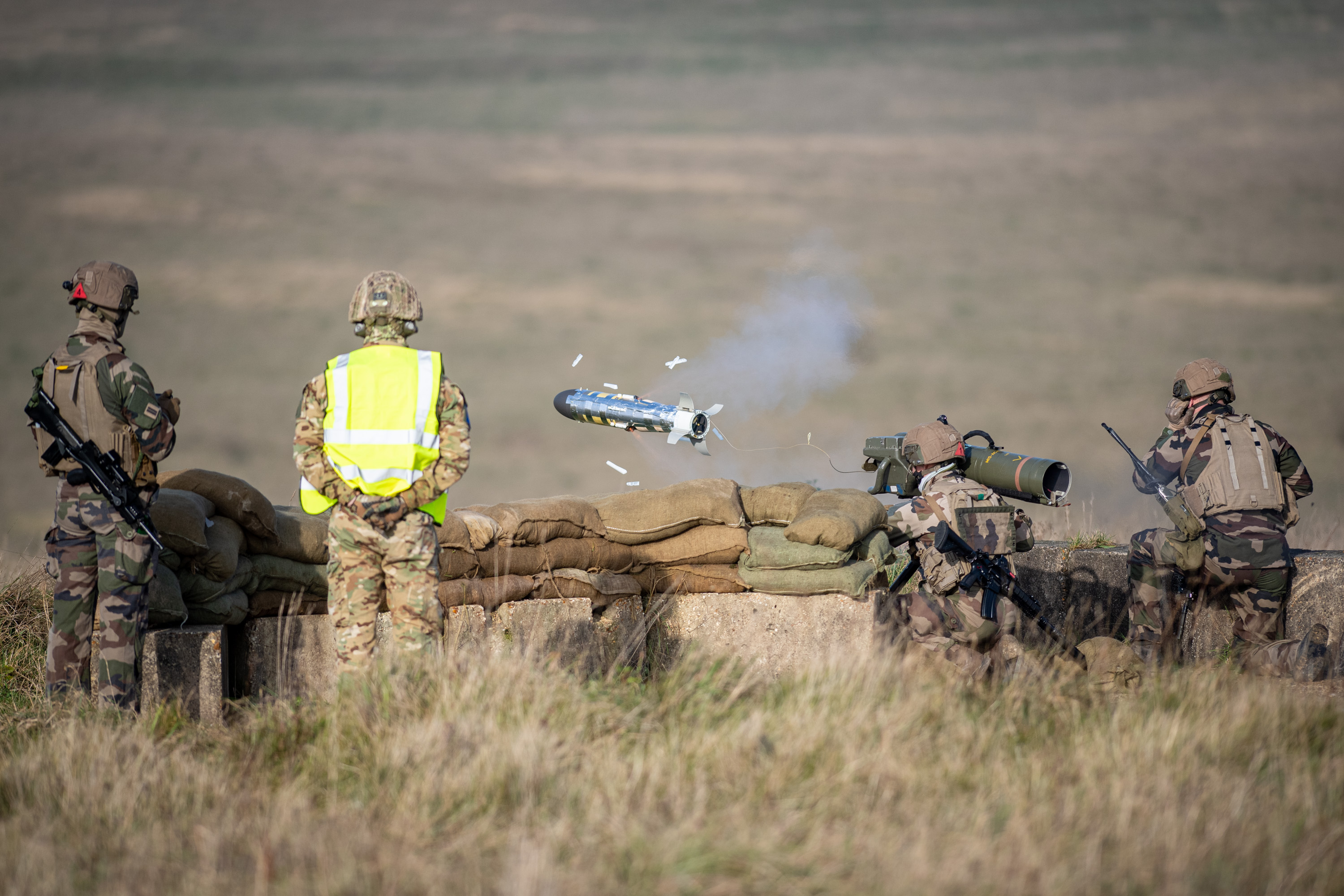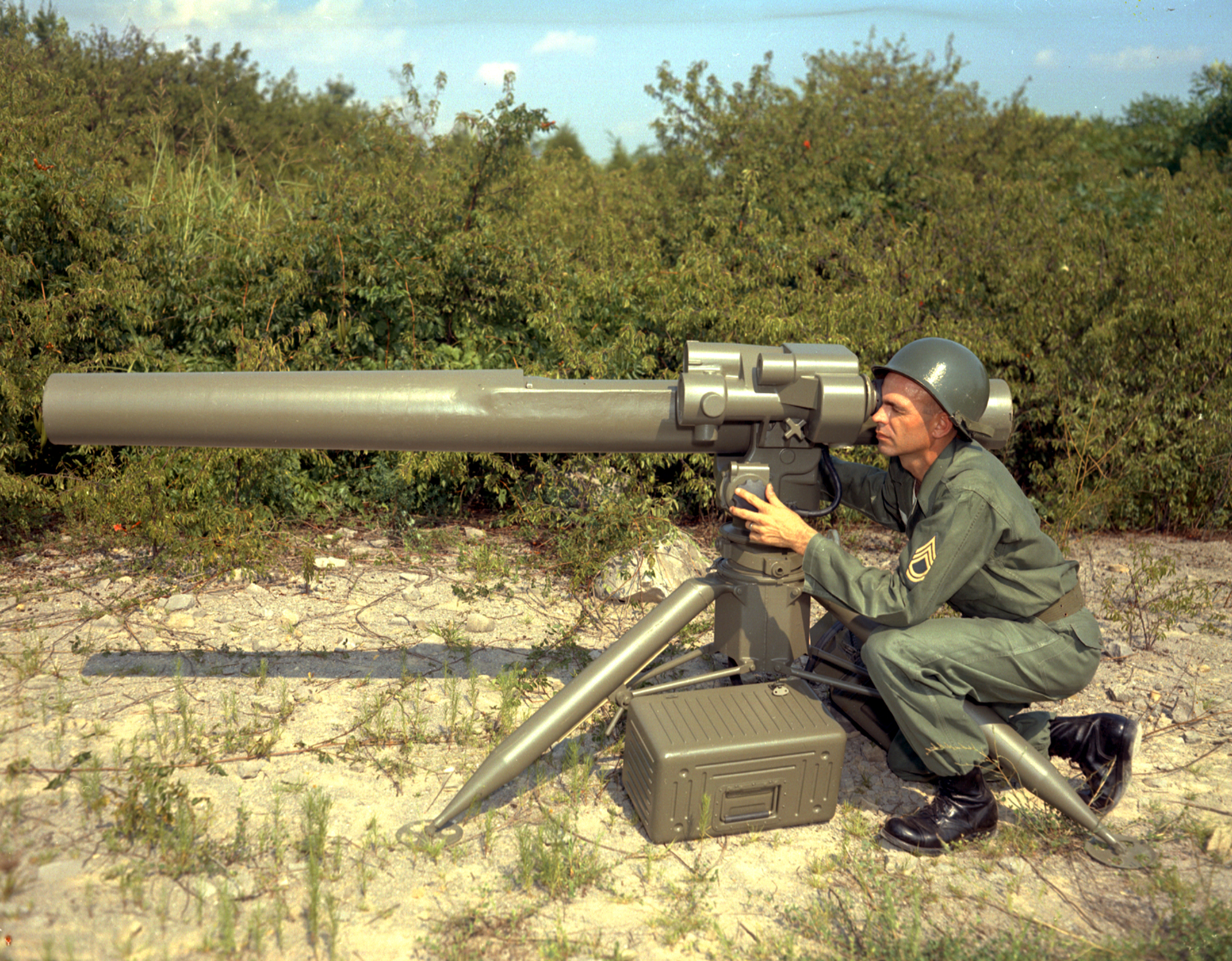|
Eryx
Eryx is a French short-range portable semi-automatic command to line of sight (SACLOS) based wire-guided anti-tank missile (ATGM) manufactured by MBDA France and by MKEK under licence. The weapon can also be used against larger bunkers and smaller pillboxes. It also has some anti-aircraft warfare ability, to bring down low flying helicopters, due to its wire-guidance system. An agreement was reached in 1989 between the French and Canadian governments to coproduce the Eryx missile system. It entered French service in 1994 and will be replaced by the upcoming AT4 F2. Development The Eryx began as a project in the late 1970s by the French Ministry of defense to replace the short range Luchaire's LRAC F1 STRIM 89mm rocket launcher in the French Army. The requirement was for a cost-effective antitank weapon that could defeat any known or future main battle tank at a maximum range of 600 meters with considerable accuracy, including on windy days. Aérospatiale, the French defens ... [...More Info...] [...Related Items...] OR: [Wikipedia] [Google] [Baidu] |
List Of Equipment Of The French Army
Modern equipment of the French Army is a list of equipment currently in service with the French Army. Figures are provided by the Ministry of Armed Forces (France), Ministry of Armed Forces for 2021. Personal equipment Uniforms Optronic devices and observation systems Special equipment Infantry equipment Pistols Assault rifles Bayonet Sniper and anti-materiel rifles Submachine guns Machine guns Shotguns Grenade launchers Portable anti-material weapons Vehicles Armoured vehicles Artillery and air defence Engineering Logistics Unarmoured vehicles Aircraft References External linksOfficial website of the French Ministry of Defense *[http://www.senat.fr/rap/r05-215/r05-215.html ''Le rôle des drones dans les armées'' – Report from the French Senate ] [...More Info...] [...Related Items...] OR: [Wikipedia] [Google] [Baidu] |
MBDA
MBDA is a European multinational developer and manufacturer of missiles.MBDA Inc. US Division Corporate Page It was created in December 2001 after the of the main French, and missile systems companies. They were the missile businesses of |
MKEK
The Mechanical and Chemical Industry Corporation ( tr, Makina ve Kimya Endüstrisi or MKE for short), established in 1950, is a reorganization of government-controlled group of factories in Turkey that supplied the Turkish Armed Forces with military products. History Its roots lie in the "Tophane-i Amire" ("Royal Arsenal") built in the latter part of the 15th Century to supply the Ottoman Empire's artillery corps with cannon, powder, and shot. This was reorganized in 1832 as the "Tophane Müşavirliği" ("Arsenal of Ordnance and Artillery Marshalship") and was later formed in a department of "Harbiye Nezareti" (Ministry of War) in 1908. After World War I and the following " Young Turks" revolt, it was reorganized as the "General Directorate of Military Factories" in 1923. Today, the MKE is made up of 12 facilities that employ 7,430 personnel. Legal status The company's legal status has changed from state-owned enterprise to a corporation, with the Law Nr. 7330 dated July 3rd, 20 ... [...More Info...] [...Related Items...] OR: [Wikipedia] [Google] [Baidu] |
Anti-tank Guided Missile
An anti-tank guided missile (ATGM), anti-tank missile, anti-tank guided weapon (ATGW) or anti-armor guided weapon is a guided missile primarily designed to hit and destroy heavily armored military vehicles. ATGMs range in size from shoulder-launched weapons, which can be transported by a single soldier, to larger tripod-mounted weapons, which require a squad or team to transport and fire, to vehicle and aircraft mounted missile systems. Earlier man-portable anti-tank weapons like anti-tank rifles and magnetic anti-tank mines, generally had very short range, sometimes on the order of metres or tens of metres. Rocket-propelled high-explosive anti-tank (HEAT) systems appeared in World War II and extended range to the order of hundreds of metres, but accuracy was low and hitting targets at these ranges was largely a matter of luck. It was the combination of rocket propulsion and remote wire guidance that made the ATGM much more effective than these earlier weapons, and gave lig ... [...More Info...] [...Related Items...] OR: [Wikipedia] [Google] [Baidu] |
Tandem-charge
A tandem-charge or dual-charge weapon is an explosive device or projectile that has two or more stages of detonation, assisting it to penetrate either reactive armour on an armoured vehicle or strong structures. Anti-tank Tandem charges are effective against reactive armour, which is designed to protect an armoured vehicle (mostly tanks) against anti-tank munitions. The first stage of the weapon is typically a weak charge that either pierces the reactive armour of the target without detonating it, leaving a channel through the reactive armour so that the second warhead may pass unimpeded, or simply detonates the armour, causing the timing of the counter-explosion to fail. The second detonation from the same projectile (which defines it as a tandem charge) attacks the same location as the first detonation where the reactive armour has been compromised. Since the regular armour plating is often the only defence remaining, the main charge (second detonation) has an increased li ... [...More Info...] [...Related Items...] OR: [Wikipedia] [Google] [Baidu] |
Charge-coupled Device
A charge-coupled device (CCD) is an integrated circuit containing an array of linked, or coupled, capacitors. Under the control of an external circuit, each capacitor can transfer its electric charge to a neighboring capacitor. CCD sensors are a major technology used in digital imaging. In a CCD image sensor, pixels are represented by p-doped metal–oxide–semiconductor (MOS) capacitors. These MOS capacitors, the basic building blocks of a CCD, are biased above the threshold for inversion when image acquisition begins, allowing the conversion of incoming photons into electron charges at the semiconductor-oxide interface; the CCD is then used to read out these charges. Although CCDs are not the only technology to allow for light detection, CCD image sensors are widely used in professional, medical, and scientific applications where high-quality image data are required. In applications with less exacting quality demands, such as consumer and professional digital cameras, act ... [...More Info...] [...Related Items...] OR: [Wikipedia] [Google] [Baidu] |
BGM-71 TOW
The BGM-71 TOW ("Tube-launched, Optically tracked, Wire-guided") is an American anti-tank missile. TOW replaced much smaller missiles like the SS.10 and ENTAC, offering roughly twice the effective range, a more powerful warhead, and a greatly improved semi-automatic command to line of sight (SACLOS) that could also be equipped with infrared cameras for night time use. First produced in 1970, TOW is one of the most widely used anti-tank guided missiles. It can be found in a wide variety of manually carried and vehicle-mounted forms, as well as widespread use on helicopters. Originally designed by Hughes Aircraft in the 1960s, the weapon is currently produced by Raytheon. History Previous designs Late in World War II, the German Army began experimenting with modified versions of the Ruhrstahl X-4 wire-guided missile. Originally developed for the ''Luftwaffe'' as an anti-bomber weapon, by changing the warhead to one using a high-explosive anti-tank (HEAT) design, the new X-7 vers ... [...More Info...] [...Related Items...] OR: [Wikipedia] [Google] [Baidu] |
Middle Eastern
The Middle East ( ar, الشرق الأوسط, ISO 233: ) is a geopolitical region commonly encompassing Arabia (including the Arabian Peninsula and Bahrain), Asia Minor (Asian part of Turkey except Hatay Province), East Thrace (European part of Turkey), Egypt, Iran, the Levant (including Ash-Shām and Cyprus), Mesopotamia (modern-day Iraq), and the Socotra Archipelago (a part of Yemen). The term came into widespread usage as a replacement of the term Near East (as opposed to the Far East) beginning in the early 20th century. The term "Middle East" has led to some confusion over its changing definitions, and has been viewed by some to be discriminatory or too Eurocentric. The region includes the vast majority of the territories included in the closely associated definition of Western Asia (including Iran), but without the South Caucasus, and additionally includes all of Egypt (not just the Sinai Region) and all of Turkey (not just the part barring East Thrace). Most Mid ... [...More Info...] [...Related Items...] OR: [Wikipedia] [Google] [Baidu] |
Bolometer
A bolometer is a device for measuring radiant heat by means of a material having a temperature-dependent electrical resistance. It was invented in 1878 by the American astronomer Samuel Pierpont Langley. Principle of operation A bolometer consists of an absorptive element, such as a thin layer of metal, connected to a thermal reservoir (a body of constant temperature) through a thermal link. The result is that any radiation impinging on the absorptive element raises its temperature above that of the reservoir – the greater the absorbed power, the higher the temperature. The intrinsic thermal time constant, which sets the speed of the detector, is equal to the ratio of the heat capacity of the absorptive element to the thermal conductance between the absorptive element and the reservoir. The temperature change can be measured directly with an attached resistive thermometer, or the resistance of the absorptive element itself can be used as a thermometer. Metal bolometers us ... [...More Info...] [...Related Items...] OR: [Wikipedia] [Google] [Baidu] |
Ottawa Citizen
The ''Ottawa Citizen'' is an English-language daily newspaper owned by Postmedia Network in Ottawa, Ontario, Canada. History Established as ''The Bytown Packet'' in 1845 by William Harris (journalist), William Harris, it was renamed the ''Citizen'' in 1851. The newspaper's original motto, which has recently been returned to the editorial page, was ''Fair play and Day-Light''. The paper has been through a number of owners. In 1846, Harris sold the paper to John Bell (journalist), John Bell and Henry J. Friel. Robert Bell (1821-73), Robert Bell bought the paper in 1849. In 1877, Charles Herbert Mackintosh, the editor under Robert Bell, became publisher. In 1879, it became one of several papers owned by the Southam Newspapers, Southam family. It remained under Southam until the chain was purchased by Conrad Black's Hollinger Inc. In 2000, Black sold most of his Canadian holdings, including the flagship National Post to CanWest Global. The editorial view of the ''Citizen'' has ... [...More Info...] [...Related Items...] OR: [Wikipedia] [Google] [Baidu] |
Jane's Information Group
Jane's Information Group, now styled Janes, is a global open-source intelligence company specialising in military, national security, aerospace and transport topics, whose name derives from British author Fred T. Jane. History Jane's Information Group was founded in 1898 by Fred T. Jane, who had begun sketching ships as an enthusiast naval artist while living in Portsmouth. This gradually developed into an encyclopedic knowledge, culminating in the publishing of ''All the World's Fighting Ships'' (1898). The company then gradually branched out into other areas of military expertise. The books and trade magazines published by the company are often considered the ''de facto'' public source of information on warfare and transportation systems. Based in Greater London for most of its existence, the group was owned by the Thomson Corporation, The Woodbridge Company, then IHS Markit, before being acquired by Montagu Private Equity in 2019. Description The company name is officially ... [...More Info...] [...Related Items...] OR: [Wikipedia] [Google] [Baidu] |
Jane's International Defence Review
''Jane's International Defence Review'' (''IDR'') is a monthly magazine reporting on military news and technology. History and profile ''International Defense Review'' was established in 1968. It was published by Interavia SA (Geneva, Switzerland) until it was acquired by Jane's Publishing Group in 1987. According to one entry in WorldCat, the name of the magazine was ''International Defense Review'', but another WorldCat entry states that the name was ''International Defence Review'' from 1968 until 1995. Yet another WorldCat entry states that the title is ''IHS Jane's International Defence Review'' after 2012. The ''IDR'' is one of a number of military-related publications named after Fred T. Jane, an Englishman who first published '' Jane's All the World's Fighting Ships'' in 1898. It is a unit of Jane's Information Group, which was acquired by IHS Inc. in 2007. The magazine provides in-depth coverage and analysis of air, land and sea platforms and systems, and regularly featu ... [...More Info...] [...Related Items...] OR: [Wikipedia] [Google] [Baidu] |





